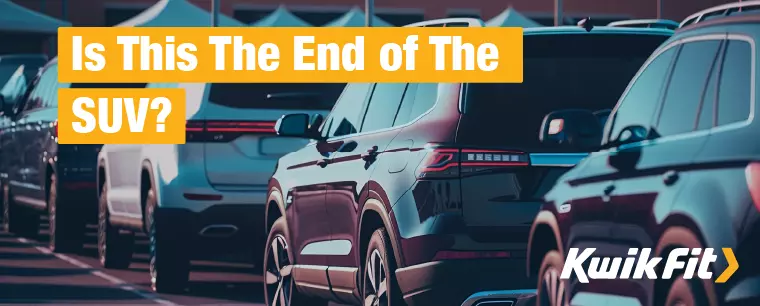Cars Are Becoming More Aerodynamic – Is This It For The SUV?
Jack Dreyer | Thursday 25th May 2023 12:30pm

Linda Jackson, the CEO of Peugeot, recently spoke on the future of car design, suggesting that the future of SUVs is in jeopardy due to the pressures of EV range. “Gone are the days”, she said at the Financial Times Future of the Car event in May, “when you [can] have a big SUV, because they're a nightmare for aerodynamics”.
With such an emphasis on a broad shift to EV use throughout the country – throughout the world, even – the focus on aerodynamics could really alter how the cars on our roads look. It could, in theory, completely eliminate the SUV category – or at least dramatically redefine how that category looks.
But this isn’t a new trend either – there have always been cars that focus on efficiency and others that don’t. Let’s explore.
This isn’t the first drive towards fuel efficiency
The fuel and energy crises throughout the 1970s put huge pressures on auto manufacturers and individuals to dramatically reduce fuel consumption – essentially in an effort to reduce costs. It’s these crises that helped propel the move to increasingly-aerodynamic cars throughout the mid-late 80s and onwards.
But this isn’t a straight line of boxy-to-aerodynamic, the design of each vehicle model reflects tastes, desires, requirements, and necessities throughout the periods in which it is sold. The move towards aerodynamics and small form-factor for entry-level cars (essentially the invention of the modern hatchback shape in the 90s) reflects a need to keep costs low.
You can likely chart this changing family tree of cars alongside world & regional economics as well as the market fortunes of the manufacturers. Cars begin to get bigger again in the early 2000s, for example, until the 2008 financial crisis forces a dramatic reassessment of manufacturing processes and market viability.
Perhaps this could be condensed into a simplified axiom: When times are good, cars get fancy, when times are tough, cars get efficient.
The growth of SUVs

SUVs, as such, are notoriously inefficient vehicles. But there are always trade-offs: while their huge size makes them usually much less aerodynamic, so significantly more costly to run on a day-to-day basis, they are also much more comfortable for driving families around.
Their increased size makes them much safer in collisions, but much more likely to have collisions or small bumps. Also, their new technologies like ADAS, TPMS, and all the other bells and whistles of modern flagship models make them more pleasant to operate, but also require more expertise to repair.
The SUV market has grown explosively over the last decade to now make up over a quarter of new car sales. Perhaps due to the boom following the 2008 financial crash – the S&P 500, for example, a stock market index tracking the value of the top 500 US tech companies, is now 3-5 times higher than its value just before the 2008 recession.
As we said: When times are good, cars get fancy.
The SUV market started as a niche one, catering originally for a very specific set of people who required multi-functional, rugged cars. This usually meant those who lived and worked in the countryside, who needed to navigate potholes and ditches on a daily basis, who had enough private space to park large vehicles. In short, if you didn’t have an SUV specifically for work, you had it for its luxuries: the comfort of a large interior for taking kids to school.
People who are cost-conscious have always tended not to drive SUVs because they have, until recently, been considered more on the luxury side of cars – as statement pieces.
But, as incomes rise, so does the desire to access luxury items previously out of reach – and this growing demand for the item has the effect of bringing costs down. That is, the desire to access the luxury car market grows until the most recent cost of living crisis – with two in three drivers now claiming to be reducing driving overall in an attempt to cut fuel costs and 49% of drivers avoiding regular car maintenance.
So, is this really ‘the end’ of the SUV, and is that a bad thing?
The end of the SUV?
The move towards aerodynamic design is now happening for two main reasons: firstly, the attempt to cut fuel consumption but secondly, and more importantly, to cut the amount of energy required to move the vehicle. With growing awareness and concern around the effects of climate change, the move to EVs is an attempt to maintain individual freedom of movement without impacting the environment. But that energy still needs to be generated somehow, and range is everything in the world of EVs. It’s no good having the nicest-looking car if it can’t get you anywhere.
When it comes to cost, there will always be a segment to whom it doesn’t matter – those who don’t mind using twice the amount of fuel for a city-trip Land Rover because the cost of the fuel is irrelevant – but you can’t buy extra range on the fly. So, this indicates that those drivers who can afford to spend the extra are always going to put it into the vehicle with the most range – assuming comfort and build quality are roughly comparable, of course.
The SUV, then, is likely to become a rarer vehicle over the next decade until, hopefully, green electricity generation becomes affordable and widespread enough for cost to not matter and EV technology gets to the point where range is no longer an issue (such as with ultra fast charging).
Stay in the loop with our blog
For more industry information, helpful guides, and interesting articles, check out our blog. Or, if you have any questions about your vehicle — SUV or otherwise — get in touch with the team at your local Kwik Fit centre.
Any facts, figures and prices shown in our blog articles are correct at time of publication.
Featured Articles
Is it Illegal to Drive With One Headlight?
Saturday 19th July 2025
Wondering if it’s illegal to drive with one headlight? Learn about the safety risks and penalties of illegal blown bulbs and why you should fix them promptly.
Air Con in EVs & Hybrids: Experts Answer Your Questions
Monday 30th June 2025
Does air con drain EV batteries? Can you use the air con while charging an electric car? Find out the answers to these questions & more from Kwik Fit’s experts.
Why Is Your Car Making a Noise? Fixes & Tips
Friday 13th June 2025
When your car starts making unexpected noises, it can certainly be quite disconcerting; it may be nothing to worry about, but here’s what you need to know.









